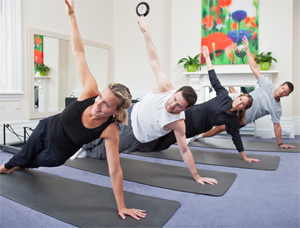 What is Pilates
What is Pilates
Pilates is a physical fitness method that was developed in the early 20th century by Joseph Pilates. Pilates was formed by Joseph during the First World War with the intention to improve the rehabilitation programme for casualties, designed to aid injured soldiers in regaining their health by strengthening, stretching, and stabilizing key muscles.
His ideology was very ahead of his time.
Joseph preferred fewer, more precise movements, requiring control and technique over increased repetition. He believed that mental and physical health were essential to one another, creating a method of total body conditioning.
Pilates exercises build strength, flexibility and lean muscle tone with an emphasis on lengthening the body and aligning the spine, rather than on bulking and shortening the muscles.
The focus on strengthening the core and improving postural awareness are especially well indicated for the alleviation and prevention of back, neck and joint pain.
Principles of Pilates
Breathing
Focus is placed on the breath to facilitate movement within a specific exercise.
Control & Concentration
Control and precision are direct by-products of the strong mind-body connection developed by proper breathing and concentration.
Centering
All movement radiates outward from the center in Pilates and the ultimate goal of Pilates is to create an even and balanced musculature.
Relaxation
An essential but often under emphasized principle of Pilates is Relaxation. It takes a while to learn to release unnecessary tension in our bodies which helps us to find ease and flow in movement.
Flowing movement
Pilates exercises train several muscle groups at once in smooth, continuous movements. By developing proper technique, you can actually re-train your body to move in safer, more efficient patterns of motion - invaluable for injury recovery, sports performance, good posture and optimal health.
What are the benefits of Pilates?
A mind-body workout
With a focus on correct breathing, correct spinal and pelvic alignment, and concentration on smooth, flowing movement, you become more in tune with your body, learning how to control movement.
In Pilates the quality of movement is valued over quantity of repetitions. Proper breathing is essential, and helps you execute movements with maximum power and efficiency.
Develop a strong core - abdominals and a strong back
The core consists of muscles of the trunk and pelvis, deep abdominal muscles along with the muscles closest to the spine. These are the focus of most Pilates exercises. Control of the core is achieved by integrating movements of the trunk, pelvis and shoulder girdle with symmetry and efficiency.
Gain flexibility
Pilates elongates and strengthens, improving muscle elasticity and joint mobility. A body with balanced strength and flexibility is less likely to be injured.
Develop a balanced conditioned body and help prevent injuries
Some sports or occupations tend to work the same muscles in a pattern of overuse. This may result in muscular imbalance - a primary cause of injury and chronic back pain.
Pilates conditions the whole body. No muscle group is over trained or under trained. Your entire musculature is evenly balanced and conditioned, helping you enjoy daily activities and sports with greater ease, better performance and less chance of injury. That’s why so many athletes or sports team are starting to include Pilates as a part of their training regimen.
It can be gentle…or as challenging as you wish!
Many of the exercises are low impact and partially weight bearing. Pilates is very safe. Modifications to the exercises allow for a range of difficulty ranging from beginner to advanced.
Pilates isn’t the type of workout where you leave feeling tired and disheveled. Instead you will leave with increased energy levels and a body that feels strong and in control having been through a challenging workout.
